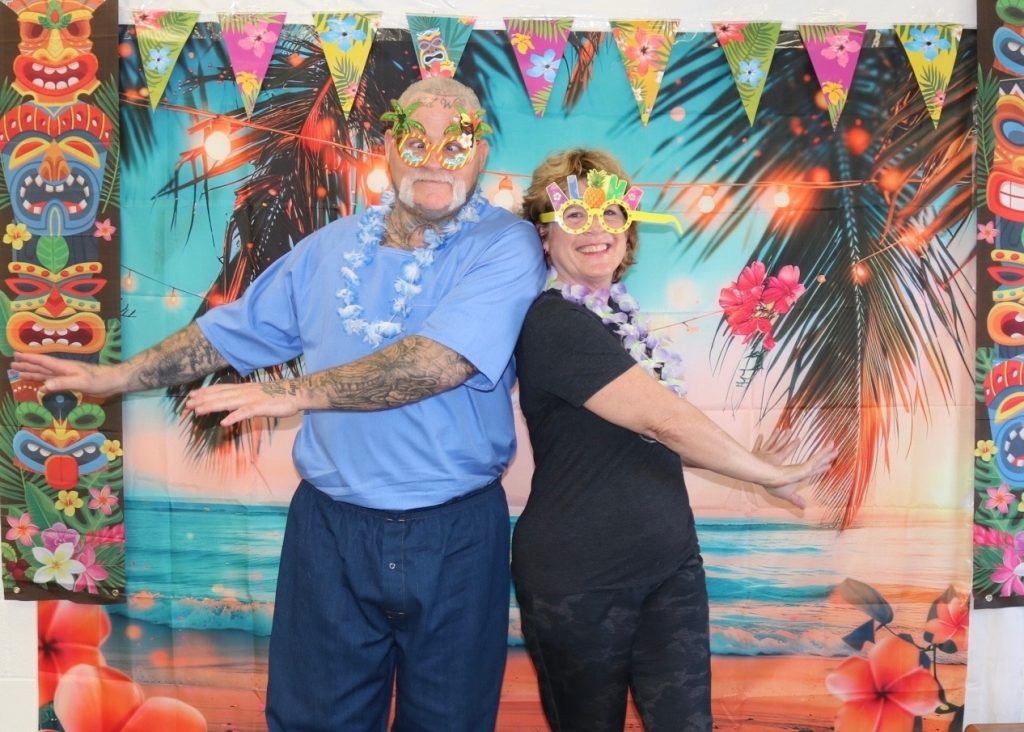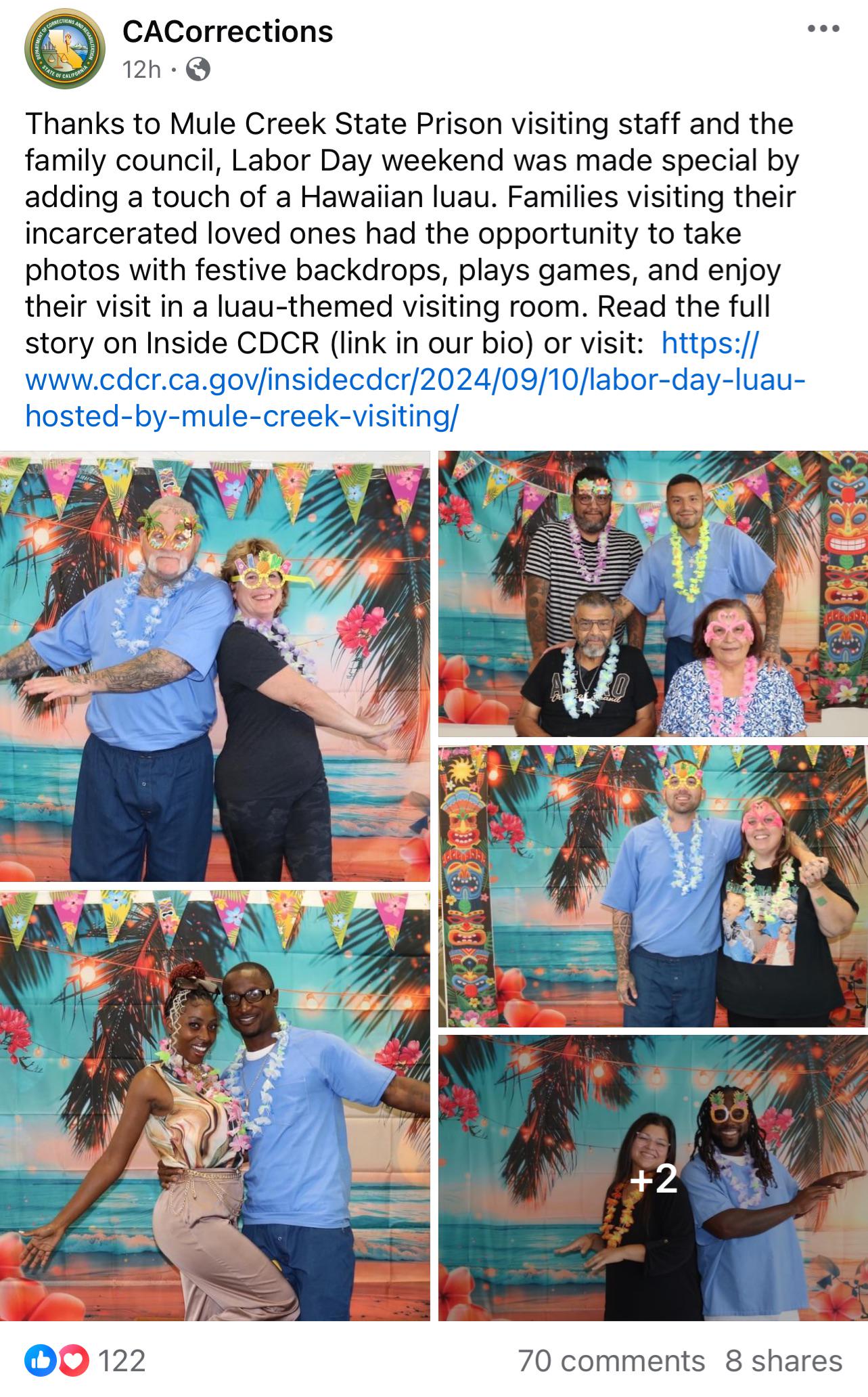The California Department of Corrections and Rehabilitation is experiencing a large increase of violence inside of its prisons. While CDCR chooses to hide this information, the Department is proud to post stories of the inmates having a good time.
While CDCR chose to post a story of the inmates having a good time during a luau in Mule Creek State Prison visiting. The Toughest Beat would like to show you the other side of the story. Below are the violent incidents at MCSP from Friday to Tuesday. CDCR wants the public to think these convicted felons are great luau partners while ignoring the violence.
On Friday, September 6, 2024, at about 1502 hours, at MCSP, Inmate Bevis resisted a peace officer requiring the use of force to gain compliance.
On Saturday, September 7, 2024, at about1121 hours, at MCSP, several inmates were battering other inmates requiring the use of force to stop the fights.
On Saturday, September 7, 2024, at about 1150 hours, at MCSP, Inmate Mears assaulted a peace officer requiring the use of force to stop the attack.
On Saturday, September 7, 2024, at about 1531 hours, at MCSP, Inmate Fleming battered another inmate until staff were required to use force to stop the attack.
On Saturday, September 7, 2024, at about 1810 hours, at MCSP, Inmate Marruffo used an inmate manufactured weapon to batter another inmate.
On Monday, September 9, 2024, at about1140 hours, at MCSP, Inmate Carter was found in possession of an inmate manufactured weapon.
On Monday, September 9, 2024, at about1155 hours, at MCSP, Inmate Curiel battered a peace officer requiring the use of force to stop the attack.
On Monday, September 9, 2024, at about 1548 hours, at MCSP, Inmate Moore battered a peace officer requiring the use of force to stop the attack.
On Tuesday, September 10, 2024, at about 0830 hours, at MCSP, Inmate Alvarado assaulted a peace officer requiring the use of force to stop the attack.
On Tuesday, September 10, 2024, at about 1039 hours, at MCSP, Inmate Dishman obstructed a peace officer requiring the use of force to gain control.
On Tuesday, September 10, 2024, at about 1120 hours, at MCSP, Inmate Dishman obstructed a peace officer resulting in the use of force to gain compliance.
On Tuesday, September 10, 2024, at about 1850 hours, at MCSP, Inmate Flores battered a staff member requiring the use of force to stop his attack.


As a dentist working within CDCR, I feel compelled to share a frontline perspective on the so-called “California Model.” While the intentions may sound noble on paper and are often presented with a reformist flair, the reality on the ground paints a very different picture, one that is far less idealistic and, in many ways, actively counterproductive. The implementation of this model frequently hinders the very goals it claims to pursue, and the effects ripple across the entire system, from clinical operations to institutional morale.
1. Dynamic security, in theory, is supposed to foster safety through positive staff-inmate interactions. In practice, however, it often looks like custody staff attempting to become “buddy-buddy” with incarcerated individuals. The consequences of this misguided approach are stark. Structure and discipline, a cornerstone of any secure institution, begin to erode. Patients show up late for their appointments, skip them altogether, or become emboldened to push boundaries with little fear of repercussions. What’s meant as security through engagement becomes a form of chaos masquerading as compassion. It weakens the lines that define professionalism, safety, and order. Rules become optional, expectations become negotiable, and the boundaries we rely on to function safely within a correctional setting begin to dissolve. This doesn’t just compromise security; it damages the integrity of care delivery, making it nearly impossible to maintain consistent standards.
2. Normalization is another principle that sounds admirable in a policy paper but becomes problematic in application. What’s considered “normal” for someone living freely in society cannot, and should not, be blindly applied to those in custody. If these individuals had been operating within socially accepted norms, they wouldn’t be incarcerated in the first place. The idea that we can recreate community environments behind bars is not just naïve, it can be actively harmful. It creates an environment with unrealistic expectations that inmates are neither ready for nor capable of meeting, and it confuses staff who are already navigating complex dynamics. The purpose of incarceration includes structured rehabilitation, accountability, and consequences. When normalization becomes a goal, we risk losing sight of the structured support necessary for true rehabilitation. Instead of creating pathways to change, we build illusions that serve no one.
The contradictions are especially glaring when we examine staff versus inmate privileges. Staff are not permitted to carry personal cell phones, check emails, or listen to music during work hours. These rules are strictly enforced under the rationale of maintaining professionalism and focus. Meanwhile, prisoners enjoy access to digital tablets that offer phone calls, video chats, email, and even streaming entertainment. This disparity is so extreme, it becomes offensive to those of us who follow the rules, show up every day, and contribute to society in meaningful ways. It sends a dangerous message: that compliance, diligence, and personal responsibility are less valued than appeasement and superficial equality.
3. Peer support, as endorsed by figures like Kevin Myers and Andrew Elms, is perhaps the most glaring example of ideology over expertise. The idea that incarcerated individuals, who have no formal education or certification, can effectively educate others about oral health is both insulting and dangerous. It devalues the years of training and rigorous licensing that dental professionals undergo. It also tramples on fundamental patient rights, including privacy and the expectation of competent care. We are not operating a Medi-Cal clinic here; we are running dental services within a correctional facility. The environment is unique, the risks are real, and the stakes are high. Allowing inmates into clinical spaces under the guise of being “peer educators” or quasi-providers blurs critical lines of safety and professional responsibility. Labeling inmates as “providers” is not just misleading, it creates a false equivalence that can lead to serious consequences, both legally and ethically. We cannot afford to gamble with safety or credibility in such a high-risk environment.
4. Regarding trauma-informed care, yes, acknowledging trauma is undeniably important. But this acknowledgment cannot remain an abstract ideal or a bullet point in a policy memo. Without meaningful structural change throughout the broader prison system, change that is implemented, monitored, and sustained, the concept remains largely superficial. True trauma-informed care requires a foundational shift in how institutions operate, how staff are trained, and how support systems are built. As it stands, it’s more of a feel-good checkbox than a transformative model. We’re left with diluted initiatives that lack the infrastructure to be effective, further deepening the disconnect between ideals and reality.
It is increasingly evident that this so-called model is being driven not by measurable outcomes, but by ideology. Kevin Myers, Statewide Dental Director, who has not treated a single patient over a decade, continues to shape clinical policy from an administrative perch, reportedly earning half a million dollars annually. His decisions, far removed from the daily grind of actual patient care, feel disconnected and tone-deaf. Local institutional staff meetings no longer center on improving patient outcomes or refining clinical practices; they have become echo chambers for Myers’ political agendas and reformist posturing. There is little to no discussion of clinical excellence, innovation, or practical support for frontline staff. The result is a demoralizing environment for those of us still committed to providing meaningful, high-quality care.
To underscore the disconnection, consider the recent survey distributed to staff, ostensibly to collect honest feedback about working conditions and morale. While the gesture may have been well-intentioned, the follow-up, or lack thereof, revealed its true nature. No tangible changes occurred. No issues were meaningfully addressed. The entire process felt like an exercise in optics, aimed more at checking a bureaucratic box than addressing real concerns. It left many of us feeling even more alienated.
The California Model borrows the language of reform, terms like “dignity,” “compassion,” and “rehabilitation”, but fails to ground those ideals in operational reality. What we need is not more rhetoric, but evidence-based, practical strategies that improve safety, care quality, and institutional integrity. It would help if supervising dentists, health program managers and supervising dental assistants were willing to hear us; but, they are unwilling to listen because they’ve been brainwashed by the ideology. Those of us on the frontlines are not asking to turn back the clock, we are asking to be heard, to be supported, and to practice with integrity in an environment that respects both our expertise and the unique challenges of correctional healthcare. The well-being of our patients and the safety of our colleagues depend on it.